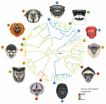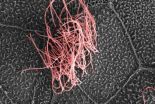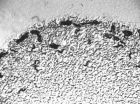(Press-News.org) MADISON –Placing a stent in a key artery in the neck is safer than ever in patients ineligible for the standard surgical treatment of carotid artery disease, according to a new study published online today in the Journal of Vascular Surgery.
A team of researchers led by Dr. Jon Matsumura, head of the vascular surgery division at University of Wisconsin School of Medicine and Public Health, found the clinical trial PROTECT (Carotid Artery Stenting with Distal Embolic Protection with Improved System) had the lowest rate of complications ever in patients considered high risk for carotid endarterectomy (CEA)—the gold standard for opening a blocked carotid artery. Carotid artery stenosis, or the narrowing of blood vessels in the neck, is one of the leading causes of strokes in the United States.
"Recent improvements in devices designed specifically for carotid artery stenting have resulted in safer procedures and better clinical outcomes," says Matsumura. "These technological advances, combined with a stronger understanding of patient risk factors, have also improved our ability to select which patients are best suited for the less invasive procedure."
The PROTECT study was a prospective, multi-center clinical trial designed to examine the safety of Emboshield Pro—an embolic protection device used in combination with stenting to help enlarge the blocked artery and capture any plaque that could dislodge during the process. The device is manufactured by Abbott Vascular, which also funded the research. Findings were peer-reviewed before publication.
The study enrolled a total of 322 patients with carotid artery stenosis at 38 centers across the United States between 2006 and 2008. The first 220 patients received a stent and Emboshield Pro, while the other 102 received a stent and an older, now obsolete embolic protection device called Emboshield BareWire. Researchers tracked the composite of clinical outcomes, including death, stroke or myocardial infarction (DSMI) up to 30-days post procedure. Of the 220 who were treated with Emboshield Pro, three patients had a minor stroke (1.4 %), one had a major stroke (0.5%), and one had a myocardial infarction (0.5%), for an overall DSMI rate of 2.3 percent, the lowest rate of complications ever recorded for the procedure in similar multicenter high-risk patient populations.
"These results are consistent with the trends from other trials, where we are seeing complication rates dropping for patients being treated with stents and embolic protection devices," Matsumura says. "This is very good news for high-risk patients suffering with carotid artery disease, who only a decade ago had limited treatment options and poor long-term outcomes."
The US Food and Drug Administration approved carotid artery stenting for high-risk surgical patients in 2004, and recently approved it for standard-risk patients in May 2011. The procedure, which is considered less invasive than carotid endarterectomy, involves a catheter being inserted in the femoral artery of the groin and guided via x-ray to the blocked artery in the neck, where a small balloon is inflated to reopen the vessel. Embolic protection devices work in tandem with stents to help support the newly opened artery and to catch any plaque that could break off during the process and cause a stroke. Strokes affect at least 731,000 people a year in the United States alone, with as many as 25 percent of them being caused by carotid artery disease.
### University of Wisconsin Hospital and Clinics is a regional training center for physicians from around the Midwest to learn how to perform advanced endovascular procedures, such as carotid artery stenting. Matsumura is currently running numerous clinical trials to help further determine the safety of stenting in lower-risk patient populations.
Co-authors of the study include Dr. William Gray, NewYork–Presbyterian/Columbia University Medical Center; Seemant Chaturvedi, Wayne State University; Dr. Dai Yamanouchi, University of Wisconsin School of Medicine and Public Health; and Lei Peng and Dr. Patrick Verta, both of Abbott Vascular Endovascular Clinical Science. Copies of the study are available upon request.
Stenting for stroke prevention becoming safer in high-risk patients
2012-01-13
ELSE PRESS RELEASES FROM THIS DATE:
Evolution is written all over your face
2012-01-13
Why are the faces of primates so dramatically different from one another?
UCLA biologists working as "evolutionary detectives" studied the faces of 129 adult male primates from Central and South America, and they offer some answers in research published today, Jan. 11, in the early online edition of the journal Proceedings of the Royal Society B. The faces they studied evolved over at least 24 million years, they report.
"If you look at New World primates, you're immediately struck by the rich diversity of faces," said Michael Alfaro, a UCLA associate professor ...
UMass Amherst chemical engineers boost petrochemical output from biomass by 40 percent
2012-01-13
AMHERST, Mass. – Chemical engineers at the University of Massachusetts Amherst, using a catalytic fast pyrolysis process that transforms renewable non-food biomass into petrochemicals, have developed a new catalyst that boosts the yield for five key "building blocks of the chemical industry" by 40 percent compared to previous methods. This sustainable production process, which holds the promise of being competitive and compatible with the current petroleum refinery infrastructure, has been tested and proven in a laboratory reactor, using wood as the feedstock, the research ...
Hubble breaks new ground with discovery of distant exploding star
2012-01-13
NASA's Hubble Space Telescope has looked deep into the distant universe and detected the feeble glow of a star that exploded more than 9 billion years ago. The sighting is the first finding of an ambitious survey that will help astronomers place better constraints on the nature of dark energy, the mysterious repulsive force that is causing the universe to fly apart ever faster.
"For decades, astronomers have harnessed the power of Hubble to unravel the mysteries of the universe," said John Grunsfeld, associate administrator for NASA's Science Mission Directorate in Washington. ...
LSU professor discovers world's tiniest vertebrate
2012-01-13
BATON ROUGE – LSU's Chris Austin recently discovered two new species of frogs in New Guinea, one of which is now the world's tiniest known vertebrate, averaging only 7.7 millimeters in size – less than one-third of an inch. It ousts Paedocypris progenetica, an Indonesian fish averaging more than 8 millimeters, from the record. Austin, leading a team of scientists from the United States including LSU graduate student Eric Rittmeyer, made the discovery during a three-month long expedition to the island of New Guinea, the world's largest and tallest tropical island.
"It ...
New species of tiny frog is world's smallest vertebrate
2012-01-13
Researchers have found two new frog species in New Guinea, one of which is the new smallest known vertebrate on Earth. The results are reported in the Jan. 11 issue of the online journal PLoS ONE, and the team of researchers was led by Christopher Austin of Louisiana State University.
The new smallest vertebrate species is called Paedophryne amauensis, named after Amau Village in Papua New Guinea, where it was found. The adult body size for these frogs ranges from just 7.0 to 8.0 millimeters.
According to Dr. Austin, the discovery "is of considerable interest to biologists ...
Selectively stopping glutathione sensitizes brain tumors to chemotherapy
2012-01-13
Brain cancer cells are particularly resistant to chemotherapy — toxins enter the cells, but before the toxins can kill, cancer cells quickly pump them back outside. In fact, brain cancer cells are even better than healthy cells at cleaning themselves. This means that when hit with chemotherapy, healthy cells tend to die before brain cancer cells. Especially in the brain, killing healthy cells is bad.
Researchers at the University of Colorado Cancer Center have discovered a way to turn off the pumps — only in brain cancer cells and not in their healthy neighbors. Promising ...
Diet counts: Iron intake in teen years can impact brain in later life
2012-01-13
Iron is a popular topic in health news. Doctors prescribe it for medical reasons, and it's available over the counter as a dietary supplement. And while it's known that too little iron can result in cognitive problems, it's also known that too much promotes neurodegenerative diseases.
Now, researchers at UCLA have found that in addition to causing cognitive problems, a lack of iron early in life can affect the brain's physical structure as well.
UCLA neurology professor Paul Thompson and his colleagues measured levels of transferrin, a protein that transports iron ...
Scientists identify gene crucial to normal development of lungs and brain
2012-01-13
La Jolla ---- Scientists at the Salk Institute for Biological Studies have identified a gene that tells cells to develop multiple cilia, tiny hair-like structures that move fluids through the lungs and brain. The finding may help scientists generate new therapies that use stem cells to replace damaged tissues in the lung and other organs.
"Cells with multiple cilia play a number of important roles, including moving fluids through the respiratory tract, brain and spinal cord," says Christopher R. Kintner, a professor in Salk's Molecular Neurobiology Laboratory, who led ...
Worm seeks worm: Caltech researchers find chemical cues driving aggregation in nematodes
2012-01-13
PASADENA, Calif.— Scientists have long seen evidence of social behavior among many species of animals, both on the earth and in the sea. Dolphins frolic together, lions live in packs, and hornets construct nests that can house a large number of the insects. And, right under our feet, it appears that nematodes—also known as roundworms—are having their own little gatherings in the soil. Until recently, it was unknown how the worms communicate to one another when it's time to come together. Now, however, researchers from the California Institute of Technology (Caltech) and ...
Discovery could help stem smoking-related diseases
2012-01-13
Sufferers of smoking related lung diseases could have their debilitating symptoms reduced following the discovery of a potential new treatment.
The discovery, by researchers at the University of Melbourne, Royal Melbourne Hospital, Australia, and the Brigham and Women's Hospital, Harvard Medical School, US, could dramatically improve treatments and slow the progression of COPD (Chronic Obstructive Pulmonary Disease) which includes the incurable condition emphysema.
COPD is a progressive disease that makes it hard to breathe and is mostly caused by excessive smoking. ...



